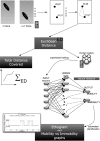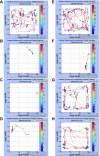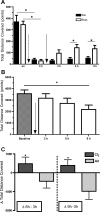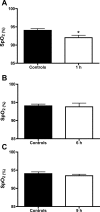Assessment of locomotion in chlorine exposed mice by computer vision and neural networks
- PMID: 22207722
- PMCID: PMC3311652
- DOI: 10.1152/japplphysiol.01023.2011
Assessment of locomotion in chlorine exposed mice by computer vision and neural networks
Abstract
Assessment of locomotion following exposure of animals to noxious or painful stimuli can offer significant insights into underlying mechanisms of injury and the effectiveness of various treatments. We developed a novel method to track the movement of mice in two dimensions using computer vision and neural network algorithms. By using this system we demonstrated that mice exposed to chlorine (Cl(2)) gas developed impaired locomotion and increased immobility for up to 9 h postexposure. Postexposure administration of buprenorphine, a common analgesic agent, increased locomotion and decreased immobility times in Cl(2)- but not air-exposed mice, most likely by decreasing Cl(2)-induced pain. This method can be adapted to assess the effectiveness of various therapies following exposure to a variety of chemical and behavioral noxious stimuli.
Figures








Similar articles
-
Nitrite therapy improves survival postexposure to chlorine gas.Am J Physiol Lung Cell Mol Physiol. 2014 Dec 1;307(11):L888-94. doi: 10.1152/ajplung.00079.2014. Epub 2014 Oct 17. Am J Physiol Lung Cell Mol Physiol. 2014. PMID: 25326579 Free PMC article.
-
Inhalation of chlorine causes long-standing lung inflammation and airway hyperresponsiveness in a murine model of chemical-induced lung injury.Toxicology. 2013 Jan 7;303:34-42. doi: 10.1016/j.tox.2012.10.022. Epub 2012 Nov 9. Toxicology. 2013. PMID: 23146759
-
Emergency management of chlorine gas exposure - a systematic review.Clin Toxicol (Phila). 2019 Feb;57(2):77-98. doi: 10.1080/15563650.2018.1519193. Epub 2019 Jan 23. Clin Toxicol (Phila). 2019. PMID: 30672349
-
Inhibition of chlorine-induced airway fibrosis by budesonide.Toxicol Appl Pharmacol. 2019 Jan 15;363:11-21. doi: 10.1016/j.taap.2018.08.024. Epub 2018 Sep 3. Toxicol Appl Pharmacol. 2019. PMID: 30189237 Free PMC article.
-
Mechanisms and modification of chlorine-induced lung injury in animals.Proc Am Thorac Soc. 2010 Jul;7(4):278-83. doi: 10.1513/pats.201001-009SM. Proc Am Thorac Soc. 2010. PMID: 20601632 Free PMC article. Review.
Cited by
-
An Official American Thoracic Society Workshop Report: Chemical Inhalational Disasters. Biology of Lung Injury, Development of Novel Therapeutics, and Medical Preparedness.Ann Am Thorac Soc. 2017 Jun;14(6):1060-1072. doi: 10.1513/AnnalsATS.201704-297WS. Ann Am Thorac Soc. 2017. PMID: 28418689 Free PMC article.
-
Halogen-Induced Chemical Injury to the Mammalian Cardiopulmonary Systems.Physiology (Bethesda). 2021 Sep 1;36(5):272-291. doi: 10.1152/physiol.00004.2021. Physiology (Bethesda). 2021. PMID: 34431415 Free PMC article. Review.
-
Postexposure aerosolized heparin reduces lung injury in chlorine-exposed mice.Am J Physiol Lung Cell Mol Physiol. 2014 Sep 1;307(5):L347-54. doi: 10.1152/ajplung.00152.2014. Epub 2014 Jul 18. Am J Physiol Lung Cell Mol Physiol. 2014. PMID: 25038191 Free PMC article.
-
Protocol for non-invasive assessment of spontaneous movements of group-housed animals using remote video monitoring.STAR Protoc. 2022 Apr 14;3(2):101326. doi: 10.1016/j.xpro.2022.101326. eCollection 2022 Jun 17. STAR Protoc. 2022. PMID: 35479115 Free PMC article.
-
Nitrite therapy prevents chlorine gas toxicity in rabbits.Toxicol Lett. 2017 Apr 5;271:20-25. doi: 10.1016/j.toxlet.2017.02.019. Epub 2017 Feb 22. Toxicol Lett. 2017. PMID: 28237808 Free PMC article.
References
-
- Akay T, Fouad K, Pearson KG. New technique for drug application to the spinal cord of walking mice. J Neurosci Methods 171: 39–47, 2008 - PubMed
-
- Dell'Omo G, Vannoni E, Vyssotski AL, Di Bari MA, Nonno R, Agrimi U, Lipp HP. Early behavioural changes in mice infected with BSE and scrapie: automated home cage monitoring reveals prion strain differences. Eur J Neurosci 16: 735–742, 2002 - PubMed
Publication types
MeSH terms
Substances
Grants and funding
LinkOut - more resources
Full Text Sources

